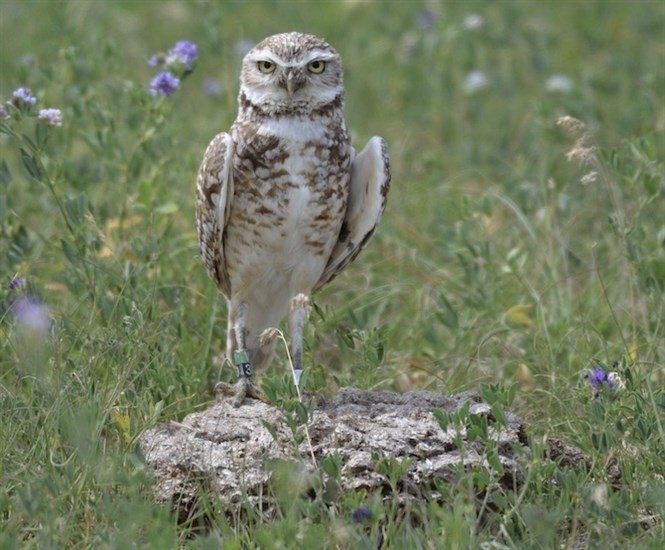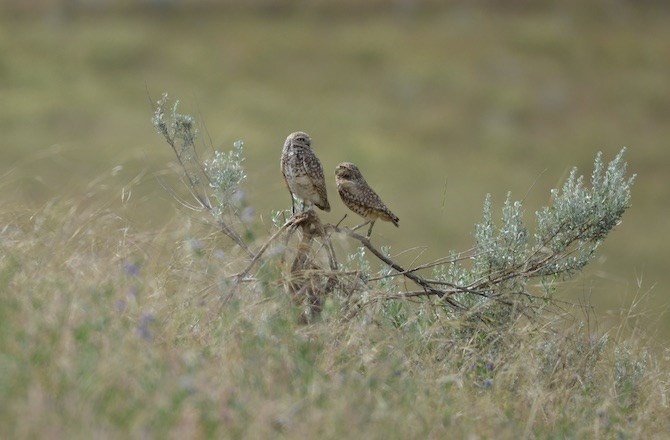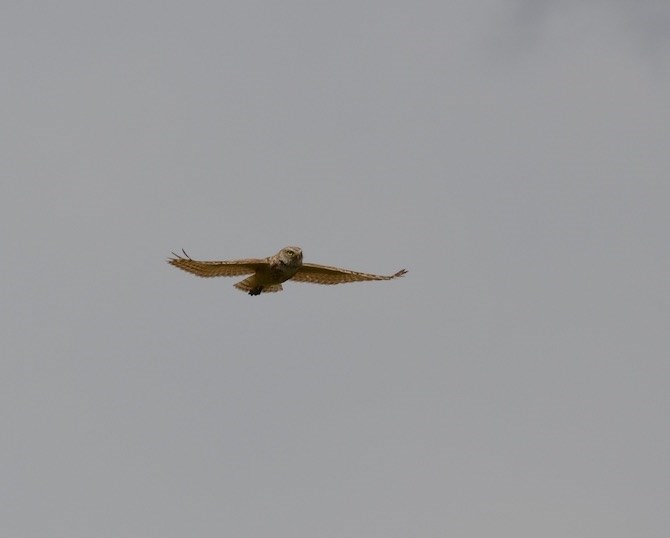
This burrowing owl is stressed by too much close contact.
Image Credit: Submitted/Lia McKinnon
June 20, 2020 - 7:00 AM
There’s way more photographers in the Interior than there are burrowing owls and that’s a real problem.
The birds are considered extinct, or extirpated, in B.C. and some recovery efforts are being hampered because too many photographers are trying to get too close to nesting sites in an effort to get that perfect shot of the only owl that lives in the ground.
“There are a couple of sites, mainly ones that are closer to Kamloops, that have been around for a long time so people have had time to hear about them and found out about them,” said Lia McKinnon, field biologist with the Burrowing Owl Conservation Society of B.C.
She suspects that one photographer found the sites and let others know, which could mean the locations have now been posted of social media and thousands of photographers know where they are.
“These people, they don’t realize that what they’re doing is a problem,” McKinnon said. “Someone told us they were using their car as a blind and their car was parked 10 metres from a burrow, if that. They go, ‘it’s fine, I’m using my car as a blind.’ It’s like, the car’s not a blind. You’re not fooling anyone. They all know you’re there and they’re stressed out.”
But, it can be hard for an untrained observer to realise they’re stressed.
So she posted pictures on Facebook and asked anyone who finds a burrow to stay at least 50 metres away.
“Even if you don’t think you are disturbing a bird (it doesn’t fly off, it isn’t alarm-calling, etc.) the bird still might not be acting normally,” she posted. “For example, it might be guarding its nest rather than foraging, leading to less food for their young and lower survival.”
While one or two people getting too close are not likely a problem, it's a numbers game with thousands of avid photographers and very few birds, she said.
If the problems with photographers persist, those sites may have to be abandoned and there are only about 13 active sites available and there are only about 70 of the birds in B.C.

Image Credit: Submitted/Lia McKinnon
The conservation society was founded by Mike Mackintosh in 1999 in an effort to stave off extinction by breeding burrowing owls in captivity and building burrows for them to live in when they’re released.
In B.C. they live in burrows in grasslands in the South Okanagan and the Nicola Valley ranging up to north of Kamloops.
Because this is the northern extension of their territory, they’re forced to migrate to Washington, Oregon and Northern California, although tagged birds have been found as far south as San Diego, Mackintosh said.
“If they were not required to migrate, we’d probably have been out of this program 10 years ago,” he said.
Migration is dangerous for all birds but the owls' wintering grounds are not necessarily secure either. They are now endangered in Washington State and near extinct in the other Western provinces.
But, there have also been birds banded in B.C. which, once they migrated, chose to remain in their new homes and not return to the chilly north.
A Canadian Wildlife Federation article said there were once 3,000 pairs of the owls in the four Western provinces but there are only about one-third as many left today as their habitat has shrunk to 36 per cent of what it was when populations started declining in the 1970s.
Despite being called burrowing owls and being the only owls that live underground, they don’t actually dig their own burrows. They move into ones abandoned by animals such as coyotes and marmots.
“They are very tiny predators living in underground burrows which are very subject to disruption by just about anything, whether it’s predators or human activity,” Mackintosh said. “They live in grasslands, which are some of the most highly sought after and most precious pieces of property in the world.”
They stand up to 30 cm tall with long legs and short stubby wings and can weigh up to 300 grams, tiny for a bird of prey.
And, unlike other birds of prey, they are quite social.
The conservation society may build four burrows in a one-acre site then another cluster five or 10 acres away, Mackintosh said. Two mating pairs may be released in one cluster.
They can have seven or eight young which, after a few weeks, will move into nearby burrows, which are dug a metre or so into the ground and connected to the surface with a pipe that may be three metres long – so quite a bit of work to set up.
Most are on private property, often cattle ranches as they co-exist quite well with cows.
The burrows are built in such a way that field workers are able to access the young for banding.
They’re bred in three locations: Oliver, Surrey and the B.C. Wildlife Park in Kamloops.
READ MORE: Burrowing owls from B.C. Wildlife Park breeding program to be released into wild
Since they are bred in captivity, the field workers visit the burrows regularly to deliver supplemental food as the birds learn how to better forage for themselves.
While they prefer field mice and voles – which males will store in their burrows to impress future breeding partners – they also eat a lot of grasshoppers and other insects.
They’re also very charismatic, McKinnon said.
Unfortunately, most people won’t get to see that side of the birds since that puts them at risk.
“I would love, at some point, to have a space where we can have a proper blind and a burrow set up where we do release owls so people can see them,” McKinnon said.
But, for now, she’s keeping the burrowing sites secret.
The Burrowing Owl Conservation Society of B.C.’s web page is here and Facebook page is here.

Image Credit: Submitted/Lia McKinnon
To contact a reporter for this story, email Rob Munro or call 250-808-0143 or email the editor. You can also submit photos, videos or news tips to the newsroom and be entered to win a monthly prize draw.
We welcome your comments and opinions on our stories but play nice. We won't censor or delete comments unless they contain off-topic statements or links, unnecessary vulgarity, false facts, spam or obviously fake profiles. If you have any concerns about what you see in comments, email the editor in the link above.
News from © iNFOnews, 2020